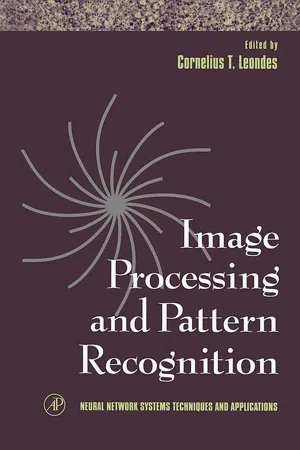
- 386 pages
- English
- ePUB (mobile friendly)
- Available on iOS & Android
Image Processing and Pattern Recognition
About this book
Image Processing and Pattern Recognition covers major applications in the field, including optical character recognition, speech classification, medical imaging, paper currency recognition, classification reliability techniques, and sensor technology. The text emphasizes algorithms and architectures for achieving practical and effective systems, and presents many examples. Practitioners, researchers, and students in computer science, electrical engineering, andradiology, as well as those working at financial institutions, will value this unique and authoritative reference to diverse applications methodologies.Coverage includes: - Optical character recognition- Speech classification- Medical imaging- Paper currency recognition- Classification reliability techniques- Sensor technology Algorithms and architectures for achieving practical and effective systems are emphasized, with many examples illustrating the text. Practitioners, researchers, and students in computer science, electrical engineering, and radiology, as wellk as those working at financial institutions, will find this volume a unique and comprehensive reference source for this diverse applications area.
Frequently asked questions
- Essential is ideal for learners and professionals who enjoy exploring a wide range of subjects. Access the Essential Library with 800,000+ trusted titles and best-sellers across business, personal growth, and the humanities. Includes unlimited reading time and Standard Read Aloud voice.
- Complete: Perfect for advanced learners and researchers needing full, unrestricted access. Unlock 1.4M+ books across hundreds of subjects, including academic and specialized titles. The Complete Plan also includes advanced features like Premium Read Aloud and Research Assistant.
Please note we cannot support devices running on iOS 13 and Android 7 or earlier. Learn more about using the app.
Information
Parallel Analog Image Processing: Solving Regularization Problems with Architecture Inspired by the Vertebrate Retinal Circuit
I INTRODUCTION
Table of contents
- Cover image
- Title page
- Table of Contents
- Copyright page
- Contributors
- Preface
- Pattern Recognition
- Comparison of Statistical and Neural Classifiers and Their Applications to Optical Character Recognition and Speech Classification
- Medical Imaging
- Paper Currency Recognition
- Neural Network Classification Reliability: Problems and Applications
- Parallel Analog Image Processing: Solving Regularization Problems with Architecture Inspired by the Vertebrate Retinal Circuit
- Algorithmic Techniques and Their Applications
- Learning Algorithms and Applications of Principal Component Analysis
- Learning Evaluation and Pruning Techniques
- Index